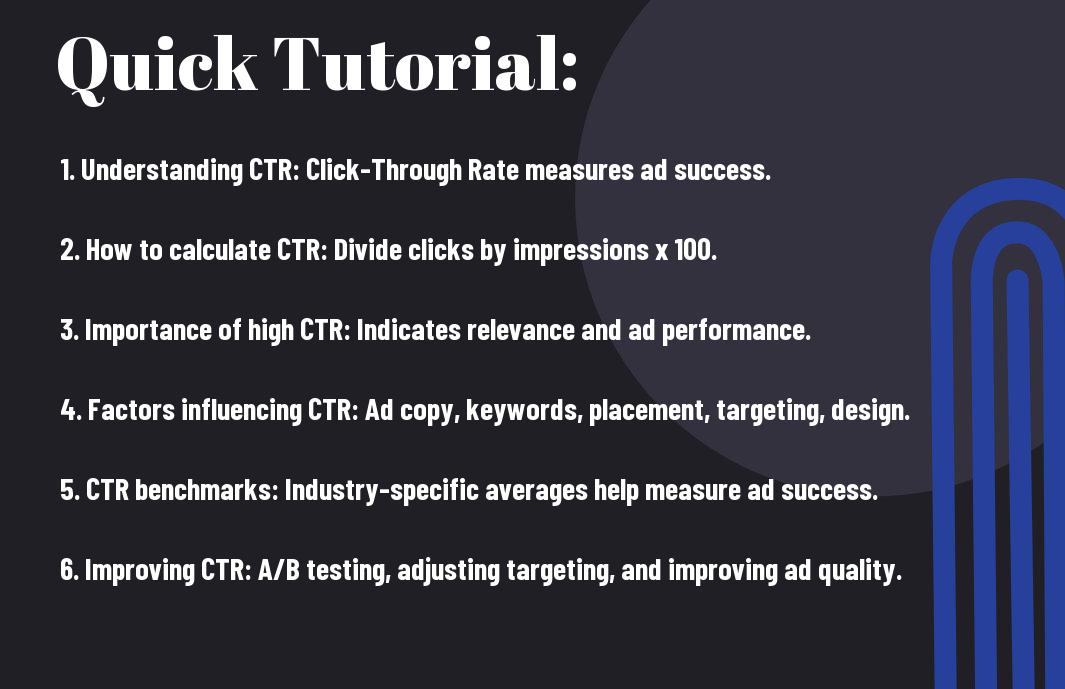Everything you wanted to know about CTR
Embark on a journey to unravel the mysteries of Click-Through Rate (CTR). Whether you’re a savvy marketer or a curious beginner, understanding CTR is crucial for achieving success in the digital realm. This in-depth guide will walk you through the ins and outs of CTR, covering its definition, significance, calculation methods, and practical tips to boost CTR effectively. Equip yourself with the knowledge to optimize your online presence and maximize your click-through opportunities. Dive into this comprehensive resource and take charge of your digital strategies with confidence.

Key Takeaways:
- Click-Through Rate (CTR) is a crucial metric that measures the effectiveness of your online marketing campaigns by showing the percentage of clicks on your ad or link among the total number of people who viewed it.
- CTR is calculated by dividing the number of clicks your ad receives by the number of times your ad is shown (impressions), then multiplying by 100.
- A high CTR indicates that your ad or content is relevant and engaging to the audience, which can help improve your ad’s placement and lower your cost per click.
- Factors that can influence CTR include ad copy, ad placement, targeting, ad extensions, and overall relevance to the audience’s needs and interests.
- Test different ad creatives, headlines, and calls-to-action to optimize your CTR and improve the performance of your campaigns.
- Regularly monitor and analyze your CTR to understand how your ads are performing and make data-driven decisions to enhance your marketing strategy.
- Improving your CTR can lead to a higher quality score, which can result in better ad placement, lower costs, and ultimately drive more traffic and conversions for your business.
Understanding CTR Metrics
How CTR is Calculated
Clearly, Click-Through Rate (CTR) is a crucial metric in digital marketing that measures the effectiveness of an ad campaign. It is calculated by dividing the number of clicks on a specific link by the number of impressions it receives, then multiplying by 100 to get a percentage.
Factors Influencing CTR
Understanding the factors influencing CTR is necessary for optimizing digital marketing strategies. Elements such as ad relevance, ad placement, and the use of compelling call-to-action phrases can greatly impact CTR.
- Ad relevance: Targeting the right audience with relevant messaging is crucial for high CTR.
- Ad placement: The placement of an ad on a webpage can significantly affect CTR.
- Compelling call-to-action: Using enticing language can encourage users to click on ads.
Any minor adjustments to these factors can result in a substantial change in CTR.
Assuming Factors Influencing CTR
With an understanding of the factors influencing CTR, digital marketers can test and optimize their campaigns to improve performance. Adapting ad copy, testing various images, and targeting specific audiences are all strategies that can positively impact CTR. Any slight modifications in these areas can lead to significant improvements in click-through rates, ultimately driving more conversions.
CTR Best Practices
Optimizing Ad Copy for Higher CTR
One of the key factors in improving your click-through rate (CTR) is optimizing your ad copy. There’s a delicate balance between being informative, engaging, and concise. Craft your ad copy to be compelling and relevant to your target audience. Use strong call-to-action language that prompts users to take action, such as “Shop Now,” “Learn More,” or “Sign Up Today.”
Effective Use of Visuals and Call-to-Action
To further boost your CTR, incorporate visually appealing elements in your ads. Eye-catching images or videos can capture users’ attention and make your ads stand out. Additionally, make sure to include a clear and prominent call-to-action button that directs users on what step to take next. A visually appealing ad combined with a strong call-to-action can significantly increase engagement.
This strategy can be particularly effective in driving conversions and maximizing your ad’s potential reach. Emphasize the most important details using bold text or colors that contrast with your ad background. Do not forget, the goal is to grab the user’s attention quickly and motivate them to click on your ad.

CTR Analysis and Improvement
Tools for Tracking CTR
With the abundance of digital marketing tools available, tracking click-through rate (CTR) has become more accessible than ever. Tools like Google Analytics, ClickMeter, and Bitly offer detailed insights into your CTR performance. These tools not only track CTR but also provide valuable data on user behavior, helping you understand what drives clicks.
Techniques for Analyzing CTR Data
Any successful digital marketing strategy involves analyzing CTR data to uncover patterns and trends. By utilizing techniques such as A/B testing, heatmaps, and cohort analysis, you can gain valuable insights into what resonates with your audience and what doesn’t. For example, A/B testing allows you to compare different versions of a campaign to see which one performs better, while heatmaps visualize where users are clicking on your page.
Improvement: When analyzing CTR data, it is crucial to focus on conversion and not just clicks. A high CTR is meaningless if it does not result in conversions. Pay attention to the quality of clicks and optimize your landing pages to ensure a seamless user experience that leads to conversion.
Advanced CTR Strategies
All CTR strategies involve a combination of techniques to optimize click-through rates. Here are some advanced strategies for enhancing your CTR:
- A/B Testing
Test Variables Results Analysis Headlines, images, CTAs Identify top-performing elements Call-to-action placement Determine best position for CTA - Personalization and Audience Targeting
Customized Content Targeted Audience
A/B Testing for CTR Optimization
You can enhance your click-through rates through A/B testing to compare different variables such as headlines, images, and CTAs. By analyzing the results, you can identify high-performing elements and optimize your content accordingly.
Personalization and Audience Targeting
There’s a growing importance of personalization in digital marketing to engage audiences better and enhance CTR. With tailored content and targeted audience segmentation, you can significantly improve the relevance and effectiveness of your campaigns. With personalization and audience targeting, you can deliver more personalized experiences that resonate with your audience, leading to higher engagement and conversion rates.
Common Pitfalls and How to Avoid Them
Avoiding Misinterpretation of CTR Data
For a successful digital marketing campaign, understanding Click-Through Rate (CTR) is crucial. However, misinterpretation of CTR data can lead to misguided decisions. The CTR should not be viewed in isolation but rather in conjunction with other metrics to provide a comprehensive understanding of campaign performance. Comparing CTR across different platforms or campaigns without considering factors such as target audience and ad placement can result in inaccurate conclusions. It is crucial to analyze the context in which the CTR data is collected to avoid misinterpreting its significance.
Balancing CTR with Other KPIs
Misinterpreting the significance of Click-Through Rate (CTR) can lead to neglecting other Key Performance Indicators (KPIs) that are equally important for measuring campaign success. Understanding how CTR fits into the overall marketing strategy and balancing it with metrics like Conversion Rate, Cost Per Acquisition, and Return on Ad Spend is crucial. While a high CTR may indicate effective ad copy and targeting, it does not guarantee conversions. Striking a balance between CTR and other KPIs ensures a more holistic evaluation of campaign performance.
The Future of CTR
Emerging Trends in CTR
Clearly, the future of Click-Through Rates (CTR) is constantly evolving with emerging trends. With the rise of digital marketing and advancements in technology, businesses are exploring new ways to boost CTR and stay ahead of the competition.
Predictive Analytics and Machine Learning
With the increasing availability of data and the advancements in technology, predictive analytics and machine learning are revolutionizing the way businesses approach CTR optimization. These tools can analyze vast amounts of data to predict user behavior and optimize campaigns for better CTR.
Understanding the power of predictive analytics and machine learning can give businesses a competitive edge in the digital landscape. By leveraging these technologies, companies can make data-driven decisions to improve their CTR and maximize their marketing efforts.

Final Words
Hence, considering the importance of Click-Through Rate (CTR) in digital marketing, it is crucial for businesses to understand its significance and how to optimize it for better results. By focusing on creating compelling ad copy, utilizing relevant keywords, and targeting the right audience, businesses can improve their CTR and ultimately drive more traffic to their websites. Constantly monitoring and analyzing CTR metrics will also help businesses make informed decisions and optimize their marketing strategies for better performance. With a thorough understanding of CTR and its impact on digital marketing efforts, businesses can effectively enhance their online visibility, attract more potential customers, and ultimately achieve their marketing goals.
FAQ
Q: What is CTR?
A: CTR stands for Click-Through Rate. It is a metric used in online advertising to measure the percentage of clicks an ad receives in relation to the number of times it is shown.
Q: Why is CTR important?
A: CTR is important because it indicates the effectiveness of an ad in capturing the audience’s attention and encouraging them to take action. It helps advertisers understand the performance of their campaigns and optimize them for better results.
Q: How is CTR calculated?
A: CTR is calculated by dividing the number of clicks an ad receives by the number of times it is shown, then multiplying by 100 to get a percentage. The formula is: (Clicks/Impressions) x 100.
Q: What is a good CTR?
A: A good CTR can vary depending on the industry, platform, and type of ad. In general, a CTR above 2% is considered decent, but strive for higher rates to indicate strong audience engagement.
Q: How can I improve my CTR?
A: To improve your CTR, focus on creating relevant ad copy, using compelling images or videos, targeting the right audience, testing different ad variations, and optimizing your ad placements and targeting settings.
Q: Does CTR impact SEO?
A: While CTR itself does not directly impact SEO, higher CTRs can lead to increased traffic to your website, potentially improving your SEO indirectly. Additionally, high CTRs can signal search engines that your content is engaging and may influence rankings.
Q: What are some common pitfalls to avoid when analyzing CTR?
A: Some common pitfalls to avoid when analyzing CTR include not considering other metrics in conjunction with CTR, focusing solely on increasing clicks without considering quality, and comparing CTR across different platforms without accounting for their unique characteristics.

